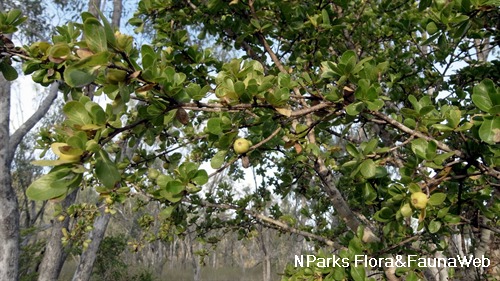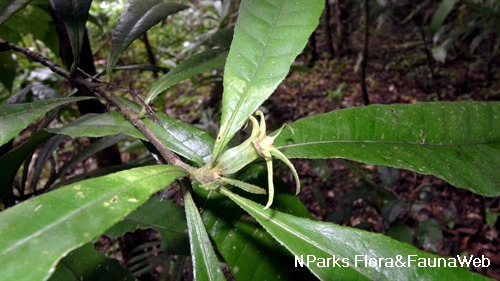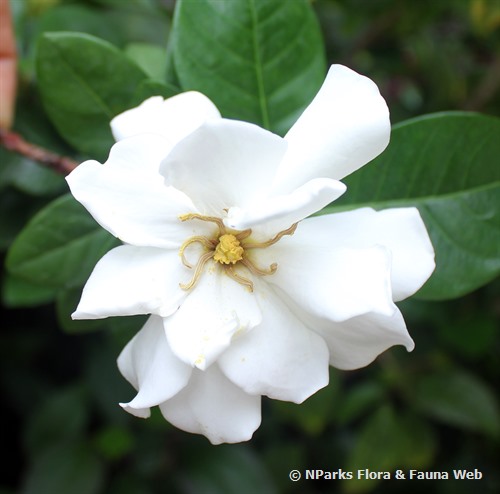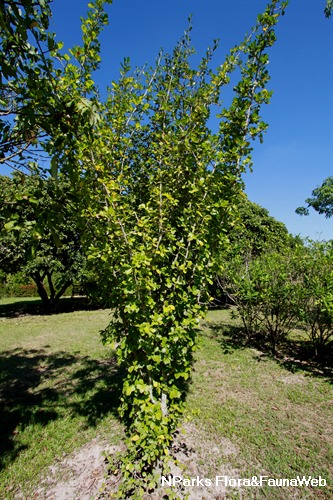.jpg)
Back
Gardenia jasminoides 'Super Star'
| Family Name: | Rubiaceae |
Gardenia jasminoides 'Super Star' is a compact shrub with small glossy green leaves. A hardy plant that produces many highly fragrant pinwheel-shaped white flowers, it is ideal for mass planting, as low hedges and borders in parks and gardens.
Name
Classifications and Characteristics
| Plant Division | Angiosperms (Flowering Seed Plants) (Dicotyledon) |
|---|---|
| Plant Growth Form | Shrub |
| Lifespan (in Singapore) | Perennial |
| Mode of Nutrition | Autotrophic |
| Plant Shape | Compact |
| Maximum Height | 1 m |
| Maximum Plant Spread / Crown Width | 1 m |
Biogeography
| Native Habitat | Terrestrial (Agricultural Land, Disturbed Area / Open Ground) |
|---|---|
| Preferred Climate Zone | Tropical |
| Local Conservation Status | Non-native (Horticultural / Cultivated Only) |
Description and Ethnobotany
| Growth Form | A low-growing compact shrub which grows to 1 m tall and 1 m wide. |
|---|---|
| Foliage | Narrow, oval to elliptical-shaped, glossy dark green leaves |
| Flowers | Fragrant, pinwheel-shaped flowers. |
| Cultivation | Plant grows best on well-draining soil. Apply fertilizer regularly to keep the shrub lush. Prune after flowering helps to promote new growth and create a bushy compact shrub. |
| Etymology | The genus Gardenia is named after Dr. Alexander Garden (1730 - 1791) who was an Anglo-American botanist. The specific epithet jasminoides means jasmine-like. |
Landscaping Features
| Landscaping | Ideal as border or low hedge and in mass planting. |
|---|---|
| Desirable Plant Features | Fragrant (Flowers) (Time Independent), Ornamental Flowers, Ornamental Foliage, Ornamental Form |
| Landscape Uses | Suitable for Bonsai, Container Planting, Flowerbed / Border, General, Groundcover, Parks & Gardens |
| Thematic Landscaping | Fragrant / Aromatherapy Garden |
Fauna, Pollination and Dispersal
| Fauna Pollination Dispersal Associated Fauna | Butterfly-Attracting, Moth Food Plant |
|---|---|
| Pollination Method(s) | Abiotic |
| Seed or Spore Dispersal | Biotic (Fauna) |
Plant Care and Propagation
| Light Preference | Full Sun |
|---|---|
| Water Preference | Moderate Water |
| Plant Growth Rate | Moderate |
| Rootzone Tolerance | Easy to Grow, Moist Soils, Well-Drained Soils |
| Propagation Method | Stem Cutting |
Foliar
| Foliage Retention | Evergreen |
|---|---|
| Mature Foliage Colour(s) | Green |
| Mature Foliage Texture(s) | Glossy / Shiny |
| Prominent Young Flush Colour(s) | Green |
| Young Flush Texture(s) | Glossy / Shiny |
| Foliar Type | Simple / Unifoliate |
| Foliar Arrangement Along Stem | Whorled |
| Foliar Attachment to Stem | Petiolate |
| Foliar Shape(s) | Non-Palm Foliage (Elliptical, Oval) |
| Foliar Venation | Pinnate / Net |
| Foliar Margin | Entire - Wavy / Undulate |
| Foliar Apex - Tip | Apiculate |
| Foliar Base | Acute |
Non - Foliar and Storage
| Stem Type & Modification | Woody |
|---|---|
| Root Type | Underground |
Floral (Angiosperm)
| Flower & Plant Sexuality | Bisexual Flowers |
| Flower Colour(s) | White |
|---|---|
| Flower Texture(s) | Smooth |
| Flower Grouping | Solitary |
| Flower Location | Axillary |
| Flower Symmetry | Radial |
| Individual Flower Shape | Stellate / Star-shaped, Tubular |
| Flowering Period | Free-Flowering |
| Flowering Habit | Polycarpic |
Fruit, Seed and Spore
| Mature Fruit Colour(s) | Orange |
|---|---|
| Mature Seed Colour(s) | Brown |
Image Repository
Others
| Master ID | 33939 |
|---|---|
| Species ID | 8355 |
| Flora Disclaimer | The information in this website has been compiled from reliable sources, such as reference works on medicinal plants. It is not a substitute for medical advice or treatment and NParks does not purport to provide any medical advice. Readers should always consult his/her physician before using or consuming a plant for medicinal purposes. |

.jpg)
.jpg)
.jpg)
.jpg)
.jpg)
.jpg)
.jpg)
.jpg)



